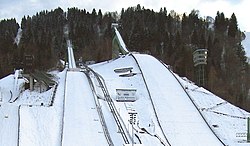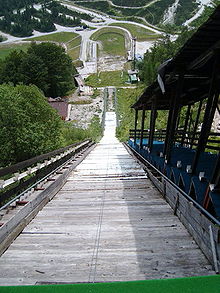Ski jump

A ski jumping hill is a sports facility and, in addition to jumping skis, is the most important piece of sports equipment for ski jumping . Sometimes the Norwegian term bakken is also used.
Jumps for top athletes are located on steep mountain slopes and allow - with the appropriate length and height difference - jumps of over 100 meters. From a hill size of 185 m and a construction point of at least 145 m, one speaks of " ski flying ".
construction

- The inrun is usually built on an artificial tower , with natural hills directly on the mountain slope . The length of the inrun can be varied by changing the exit ( hatch or gate) or by moving the start bar ( Happle bar after its inventor Wolfgang Happle ), on which the ski jumper sits before the jump begins.
- The jump table is the area where the jump takes place. Usually it is inclined approx. 10 degrees downwards.
- The landing lane is the area where landing normally occurs. It is convex closer to the take-off table and curved concave further towards the outlet . The transition between the two curves is the K point (critical point, construction point or calculation point); at this point the gradient is maximum. The construction point according to which the hill was constructed indicates the width for which it is designed and is used to determine the width points . If the K-point is skipped, the landing takes place in the flatter terrain and it becomes more and more difficult to stand because the forces acting become stronger as the flattening increases.
- The run-out is the area that sometimes rises slightly to slow down the high speed. There is space for the spectators behind a barrier.
The geometry of the ski jumping facility (length, height and inclination of the take-off, radius and inclination of the landing area) is responsible for the theoretical distance that can be jumped on a hill.
Factors that can be influenced by the jumper for a large jump distance are the technique (in approach, take-off and especially in flight), as well as the ability to take off quickly. These lead to the flight path parameters of approach speed, departure altitude and aerodynamic flight quality, which primarily determine the flight path.
In practice, there are also external factors such as the nature of the track, which is responsible for the friction and ultimately for the approach speed, or the wind (direction and strength), which can have a secondary influence on the flight path.
Sizing

Since the summer of 2004 jumps are based on the hillsize point; in different classes of (HS literally "hill size") Schanze sizes divided. The hillize point is the point at which the spout has an inclination angle of 32 °. It was introduced to better characterize the size of the hill. The forerunner of the name Hillsize was the size of the jury .
Until summer 2004, the size of a ski jumping hill was indicated by the K-point width:
| Hillsize | K-point width | |
|---|---|---|
| Ski jump | over 185 m | 145-200 m |
| Large hill | over 110 m | 100-130 m |
| Normal hill | 85-109 m | 75-99 m |
| Middle hill | 50-84 m | 46-74 m |
| Small hill | 20-49 m | 20-45 m |
Small and medium-sized hills are mainly training hills for junior jumpers. Experienced jumpers train on normal and large hills. In contrast, training on ski jumping hills outside of a competition is prohibited. The reason for this is the enormous danger that increases with the size of the hill. The ski jumper feels more air force, and the flight path heights usually also increase, which means that a fall from heights of up to six meters could be fatal.
In the World Cup , jumping is mainly on large hills. However, there are also competitions on normal hills, for example in the Villacher Alpenarena . The Continental Cup jumping and the women's competitions take place mainly on normal hills.
There are also two to four ski flying events per year. The last World Cup flying of the season usually takes place in Planica ( Letalnica ), the week before the competitions in Vikersund ( Vikersundbakken ) as part of Raw Air , the other ski flying events alternately on the jumps in Tauplitz ( Kulm ) and Oberstdorf ( Heini-Klopfer- Ski jumping hill ).
At World Championships and Olympic Games, individual competitions are held on normal and large hills. Every two years, instead of a world championship on the normal and large hill, the ski flying world championship takes place on one of the five homologated ski jumping hills.
Normal and large hills are available in many countries. B. also in China, Korea or Spain. Most of the facilities approved by the World Ski Federation (FIS) are, however, located in traditional winter sports countries in Europe as well as in North America and Japan. In Germany there are or were around 1,500 ski jumping hills, of which around 40 are normal and eight are large.
Ski jumping hills
There are currently four ski jumping hills on which World Cup competitions or world championships can be held:
| Jump | place | country | Hillsize | K-point width | annotation |
|---|---|---|---|---|---|
| Letalnica | Planica | Slovenia | 240 m | 200 m | |
| Vikersundbakken | Vikersund | Norway | 240 m | 200 m | Current world record: 253.5 m |
| Hill on the Kulm | Bad Mitterndorf | Austria | 235 m | 200 m | |
| Heini-Klopfer ski jumping hill | Oberstdorf | Germany | 235 m | 200 m |
The world record in ski flying has already been achieved at least once on all four hills .
In addition, competitions were held regularly on the Čerťák (HS 205), which was closed in 2014 , and two world records were set.
Another ski jump is the Copper Peak ski jump (K 160) in Ironwood in the US state of Michigan , which however does not have a current FIS certificate.
Plastic covered hills

Jumps covered with plastic matting are also suitable for operation in summer without snow. The landing area is covered with plastic mats, which are moistened and therefore have a sliding property similar to that of snow. In modern systems, the approach consists of a ceramic or porcelain lane.
Increasingly, very large jumping facilities are also being equipped with mats (e.g. Oberstdorf or Bischofshofen). Ski jumping is developing into a year-round sport. In addition to the traditional competitions in winter, summer competitions (e.g. the FIS Summer Grand Prix) are also becoming increasingly important. The smallest plastic covered jump in Germany is 8 m high, 20 m long and 3 m wide, the maximum jump distance is 8 m. It was built to be mobile in order to attract young talent across Germany. It is TÜV-tested and has a certification from the German Ski Association.
Trick ski jumping hills
Jumps are also used for trick skis . These have a higher take-off table than those for ski jumping competitions and the ski jumper flies diagonally upwards on these hills. Trick ski jumps are usually not permanent structures, but consist of snow.
See also
Web links
- Sandra and Ralf Sommer: ski jumps and flying hills. Photos and data from ski jumping hills. On: schanzenfotos.de.
- Ski jumping hill archive. The world's largest online archive with images and information about all known ski jumping hills and a total of almost 1000 hills in the world. On: skisprungschanzen-archiv.de.
- Construction of an inrun track using the example of Innsbruck's Bergisel ski jump. On: sportsplanet.at.
- Jumps. Overview of all World Cup and COC hills (women and men) of winter 2012/2013. On: berkutschi.com.
- Textbook: 30 ski jumping hills in the world. Receives impressive images and a blueprint for the ski jumping hill in Oberstdorf
Individual evidence
- Construction standards for ski jumping hills 2012 (PDF file; 2.12 MB). On: fis-ski.com.
- ↑ Kraft sails to a new world record. (Website) sport.orf.at, March 18, 2017, accessed on March 18, 2017 .


